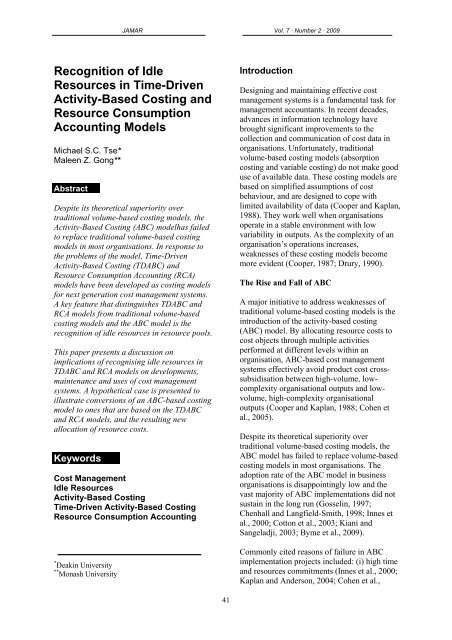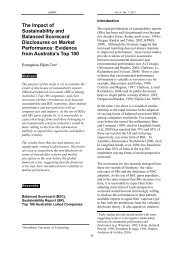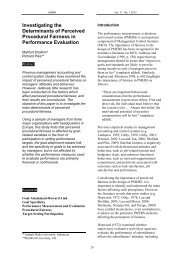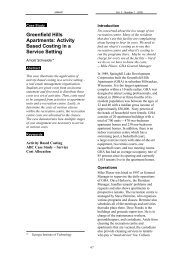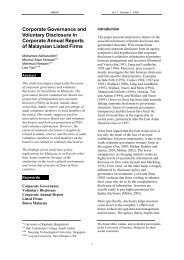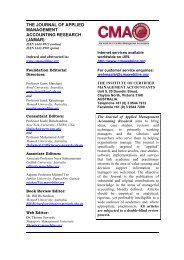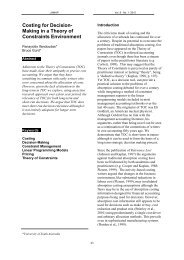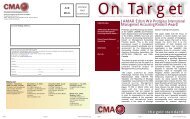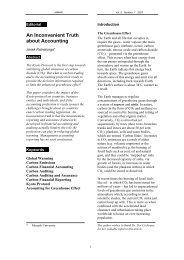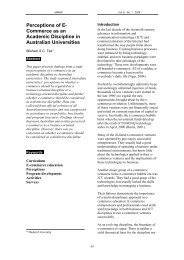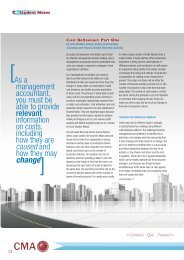Recognition of Idle Resources in Time-Driven Activity-Based ...
Recognition of Idle Resources in Time-Driven Activity-Based ...
Recognition of Idle Resources in Time-Driven Activity-Based ...
You also want an ePaper? Increase the reach of your titles
YUMPU automatically turns print PDFs into web optimized ePapers that Google loves.
JAMAR Vol. 7 · Number 2 · 2009manage product costs by chang<strong>in</strong>g quantities<strong>of</strong> organisational outputs. Under traditionalvolume-based cost<strong>in</strong>g models and the ABCmodel, costs associated with idle resources areallocated to cost objects. Product costs are<strong>in</strong>flated and management may accidentallystart the fixed cost death spiral by remov<strong>in</strong>gproducts or services that consume fewerresources than they appear to consume (van deMerwe and Keys, 2001). By remov<strong>in</strong>g impacts<strong>of</strong> idle resources on product costs, TDABCand RCA models enable cost managementsystems to provide more accurate <strong>in</strong>formationon product costs (Benjam<strong>in</strong> and Simon, 2003;Kaplan and Anderson, 2004).The ABC model differentiates itself fromtraditional volume-based cost<strong>in</strong>g models byenabl<strong>in</strong>g cost management systems to provide<strong>in</strong>formation on how operat<strong>in</strong>g activities addvalue to organisational outputs throughl<strong>in</strong>kages between resource pools and cost pools(type 2 <strong>in</strong>formation). With this type <strong>of</strong><strong>in</strong>formation, management can reduce productcosts by reduc<strong>in</strong>g or elim<strong>in</strong>at<strong>in</strong>g non valueaddedactivities (Gossel<strong>in</strong>, 1997). As both theTDABC and RCA models adopt activity-basedparadigm <strong>in</strong> the models, cost managementsystems that are based on the two models canalso provide <strong>in</strong>formation on l<strong>in</strong>kages betweenresource pools and cost pools.While adoption <strong>of</strong> the ABC model enablesmanagement to elim<strong>in</strong>ate non value-addedactivities by us<strong>in</strong>g <strong>in</strong>formation on howoperat<strong>in</strong>g activities add value to organisationaloutputs, it provides little <strong>in</strong>sights on howvalue-added activities can be managed. In theTDABC and RCA models, provision <strong>of</strong><strong>in</strong>formation on idle resources effectively fillsthis gap.As idle resources do not make directcontributions to operat<strong>in</strong>g activities, theirexistence represents <strong>in</strong>efficiencies <strong>in</strong> anorganisation’s operations. Management canimprove operational efficiency by reduc<strong>in</strong>gquantities <strong>of</strong> idle resources. <strong>Idle</strong> resources canbe reduced by either <strong>in</strong>creas<strong>in</strong>g organisationaloutputs or reduc<strong>in</strong>g quantities <strong>of</strong> committedresources (Buchheit, 2003). By provid<strong>in</strong>g<strong>in</strong>formation on idle resources <strong>in</strong> resourcepools, TDABC and RCA models enablemanagement to improve an organisation’sefficiency <strong>in</strong> perform<strong>in</strong>g its value-addedactivities.Table 1: Comparison <strong>of</strong> TDABC and RCA models<strong>Time</strong>-<strong>Driven</strong> <strong>Activity</strong><strong>Based</strong> Cost<strong>in</strong>gRelationship with other System <strong>in</strong>dependent<strong>in</strong>formation systemsOrganisation <strong>of</strong> resource Cost-based resource poolspoolsComposition <strong>of</strong> resource All resource costs arepoolsvariableCross-allocation <strong>of</strong> resource No cross allocation amongcosts among resource poolsAllocation <strong>of</strong> resource coststo cost objectsresource pools<strong>Activity</strong>-based costallocationResource ConsumptionAccount<strong>in</strong>gERP-compliantTechnology-based resourcepoolsResource costs can be eitherfixed or variableCross allocation amongresource pools is allowedBoth activity-based andvolume-based cost allocationare allowedTDABC and RCA Models <strong>in</strong> Action –Department MDepartment MIn this section, an ABC-based cost<strong>in</strong>g modelfor a hypothetical production department isconverted to two cost<strong>in</strong>g models that are basedon the TDABC model and the RCA modelrespectively. The two new cost<strong>in</strong>g models arethen used to allocate resource costs to itsproducts.Department M is a hypothetical productiondepartment <strong>in</strong> a manufactur<strong>in</strong>g firm. It is anautonomous organisational unit that <strong>in</strong>volves<strong>in</strong> production <strong>of</strong> three products, namelystandard, deluxe and premium.45
JAMAR Vol. 7 · Number 2 · 2009Figure 1: ABC-<strong>Based</strong> Cost<strong>in</strong>g Model for Department MWages &SalariesAdm<strong>in</strong>istrationStandardDepreciationAssemblyDeluxeEnergyQualityControlPremiumFactorySuppliesFigure 1 presents an ABC-based cost<strong>in</strong>g modelfor allocation <strong>of</strong> resource costs <strong>in</strong> departmentM. Four resource pools, namely wages andsalaries, depreciation, energy and factorysupplies are identified <strong>in</strong> the model. Resourcecosts for the current account<strong>in</strong>g period arepresented <strong>in</strong> Table 2.The four resource pools are l<strong>in</strong>ked to threeactivity pools: adm<strong>in</strong>istration, assembly andquality control. Adm<strong>in</strong>istration is a facilitylevelactivity that bears no relationship withoutput levels while assembly and qualitycontrol are unit-level and batch-level activitiesrespectively. After allocat<strong>in</strong>g resource costs tothe three activity pools, activities costs aresubsequently allocated to three cost objects(product l<strong>in</strong>es): standard, deluxe and premium.Quantities <strong>of</strong> resource drivers and activitydrivers for the current account<strong>in</strong>g period arepresented <strong>in</strong> tables 3 and 4 and outcomes <strong>of</strong> theallocation process are presented <strong>in</strong> table 5 and6.Table 2: Resource Costs and Resource DriversResource Cost Resource DriverWages and Salaries $100,000 Labour HourDepreciation $150,000 Square MetreEnergy $20,000 KilowattFactory Supplies $7,500 KilogramTable 3: Quantities <strong>of</strong> Resource DriversResource Driver Adm<strong>in</strong>istration Assembly Quality ControlLabour Hour 2,500 7,000 500Square Metre 2,000Kilowatt 30,000Kilogram 6,000 1,50046
JAMAR Vol. 7 · Number 2 · 2009Table 4: <strong>Activity</strong> Drivers<strong>Activity</strong> <strong>Activity</strong> Driver Standard Deluxe PremiumAdm<strong>in</strong>istration Product L<strong>in</strong>e 1 1 1Assembly Unit <strong>of</strong> Production 2,200 1,000 300Quality Control Inspection 88 100 60Table 5: Allocation <strong>of</strong> Resource Costs to Activities – ABC-<strong>Based</strong> Cost<strong>in</strong>g ModelResource Adm<strong>in</strong>istration Assembly Quality ControlWages and Salaries $25,000.00 $70,000.00 $5,000.00Depreciation $150,000.00Energy $20,000.00Factory Supplies $6,000.00 $1,500.00Total $25,000.00 $246,000.00 $6,500.00Table 6: Allocation <strong>of</strong> <strong>Activity</strong> Costs to Product L<strong>in</strong>es – ABC-<strong>Based</strong> Cost<strong>in</strong>g Model<strong>Activity</strong> Cost per <strong>Activity</strong> Driver Standard Deluxe PremiumAdm<strong>in</strong>istration $8,333.33 $8,333.34 $8,333.33 $8,333.33Assembly $70.29 $154,628.57 $70,285.71 $21,085.71Quality Control $26.21 $2,306.45 $2,620.97 $1,572.58Total $165,268.36 $81,240.02 $30,991.62From ABC to TDABCConversion <strong>of</strong> an ABC-based cost<strong>in</strong>g model toa TDABC-based one is relatively simple.Relationships between resource pools,activities and cost objects identified <strong>in</strong> theABC-based cost<strong>in</strong>g model can be adopted <strong>in</strong>TDABC-based model directly and <strong>in</strong>formationprovided by ABC-based cost managementsystem can be used to derive the resourceactivitydrivers.Figure 2 presents a TDABC-based cost<strong>in</strong>gmodel for Department M. In the first glance,the new TDABC-based model does not lookmuch different from the ABC-based model.The two models have same resource cost pools,same activities and same cost objects.However, under the TDABC-based model,there is no activity pool <strong>in</strong> the model. Resourcepools are l<strong>in</strong>ked to cost objects directlythrough resource-activity cost drivers (Kaplanand Anderson, 2004; Barrett, 2005). Eachresource-activity cost driver represents an<strong>in</strong>dependent l<strong>in</strong>k between a resource pool anda cost object that consume a particular activity.In Department M’s case, each resource pool isl<strong>in</strong>ked to one to three resource-activity costdrivers. The number <strong>of</strong> resource-activity costdriver between a resource pool and a costobject depends on the number <strong>of</strong> activities thatconsume the same resource. For <strong>in</strong>stance, thewages and salaries cost is consumed by all <strong>of</strong>three activities (adm<strong>in</strong>istration, assembly andquality control). Therefore, the wages andsalaries cost is l<strong>in</strong>ked to all cost objectsthrough three separate resource-activity costdrivers. In contrast, the energy cost is onlyl<strong>in</strong>ked to cost objects through one resourceactivitydriver as the energy cost is consumedby the assembly activity only. The value <strong>of</strong> aresource-activity cost driver is calculated bymultiply<strong>in</strong>g resource costs per hour andnumber <strong>of</strong> hours for an activity (Kaplan andAnderson, 2004; 2007). Table 7 presents the<strong>in</strong>formation on resource costs per hour for eachresource. For depreciation, the level <strong>of</strong>capacity (7,200 hours) is determ<strong>in</strong>ed by thelevel <strong>of</strong> capacity <strong>of</strong> the resource that serves thesame activity (i.e. energy).Table 8 presents the <strong>in</strong>formation on time spenton each activity. The adm<strong>in</strong>istration activity isa facility-level activity and each product l<strong>in</strong>e isassumed to consume same amount <strong>of</strong>adm<strong>in</strong>istration cost. As such, the number <strong>of</strong>hours spent on each product l<strong>in</strong>e is equal to thetotal number <strong>of</strong> hours spent on adm<strong>in</strong>istrationactivities (2,550 hours) divided by number <strong>of</strong>product l<strong>in</strong>es and the resource-activity driverfor allocat<strong>in</strong>g wages and salaries cost (the onlyresource cost for the adm<strong>in</strong>istrative activity) toeach product l<strong>in</strong>e is equal to the wages andsalaries cost per hour cost multiplies thenumber <strong>of</strong> hours spent on each product l<strong>in</strong>e.47
JAMAR Vol. 7 · Number 2 · 2009Figure 2: TDABC-<strong>Based</strong> Cost<strong>in</strong>g Model for Department MWages &SalariesStandardDepreciationDeluxeEnergyPremiumFactorySupplies.Table 7: Resource Costs per HourResource Capacity (hours) Cost per HourWages and Salaries 10,000 $10.00Depreciation 7,200 $20.83Energy 7,200 $2.78Factory Supplies 7,500 $1.00Table 8: <strong>Activity</strong> <strong>Time</strong>s<strong>Activity</strong> Level Unit <strong>of</strong> <strong>Activity</strong> ProductL<strong>in</strong>e<strong>Time</strong> per Unit(hours)Number <strong>of</strong> Units Total <strong>Time</strong>(hours)Adm<strong>in</strong>istration Facility Product L<strong>in</strong>e - 850 3 2,550Assembly Unit Unit <strong>of</strong> Production Standard 1.8 2,200 3,960Deluxe 2.2 1,000 2,200Premium 3.0 300 900Quality control Batch Inspection Standard 0.5 88 44Deluxe 0.5 100 50Premium 1.0 60 60Total 9,764In comparison, assembly activity is a unit-levelactivity and the unit <strong>of</strong> activity is the number<strong>of</strong> units <strong>in</strong> each product l<strong>in</strong>e. As amounts <strong>of</strong>time used to produce a unit <strong>in</strong> each productl<strong>in</strong>e differs, each resource-activity driver forallocation <strong>of</strong> a resource cost to a particularproduct l<strong>in</strong>e has a different value. Each <strong>of</strong>them is equal to the per hour cost <strong>of</strong> thatresource multiplied by the number <strong>of</strong> hoursspent on produc<strong>in</strong>g a unit <strong>in</strong> a particularproduct l<strong>in</strong>e.Quality control activity, as a batch-levelactivity, uses the number <strong>of</strong> <strong>in</strong>spections asunits <strong>of</strong> activity. A resource-activity driver foreach product l<strong>in</strong>e is equal to the per hour cost<strong>of</strong> a resource multiplied by the number <strong>of</strong>hours spent on an <strong>in</strong>spection.After determ<strong>in</strong><strong>in</strong>g values <strong>of</strong> all resourceactivitydrivers, the resource costs are allocatedto the three product l<strong>in</strong>es. The outcomes <strong>of</strong> theallocations <strong>of</strong> resource costs are presented <strong>in</strong>48
JAMAR Vol. 7 · Number 2 · 2009Tables 9-14. As shown <strong>in</strong> Table 14, not allcommitted resource costs are allocated to theproduct l<strong>in</strong>es. The difference between aresource cost and the total resource costallocated to the three product l<strong>in</strong>es is the cost<strong>of</strong> idle resources.Table 9: Allocation <strong>of</strong> Wages and Salaries Cost to Product L<strong>in</strong>es – TDABC-<strong>Based</strong> Cost<strong>in</strong>g ModelProduct L<strong>in</strong>e <strong>Activity</strong> Resource-<strong>Activity</strong> Driver Unit <strong>of</strong> <strong>Activity</strong> Cost AllocatedStandard Adm<strong>in</strong>istration $8,500.00 1 $8,500.00Assembly $18.00 2,200 $39,600.00Quality control $5.00 88 $440.00Deluxe Adm<strong>in</strong>istration $8,500.00 1 $8,500.00Assembly $22.00 1,000 $22,000.00Quality control $5.00 100 $500.00Premium Adm<strong>in</strong>istration $8,500.00 1 $8,500.00Assembly $30.00 300 $9,000.00Quality control $10.00 60 $600.00Total $97,640.00Table 10: Allocation <strong>of</strong> Depreciation Cost to Product L<strong>in</strong>es – TDABC-<strong>Based</strong> Cost<strong>in</strong>g ModelProduct L<strong>in</strong>e <strong>Activity</strong> Resource-<strong>Activity</strong> Driver Unit <strong>of</strong> <strong>Activity</strong> Cost AllocatedStandard Assembly $37.50 2,200 $82,500.00Deluxe Assembly $45.83 1,000 $45,833.33Premium Assembly $62.50 300 $18,750.00Total $147,083.33Table 11: Allocation <strong>of</strong> Energy Cost to Product L<strong>in</strong>es – TDABC-<strong>Based</strong> Cost<strong>in</strong>g ModelProduct L<strong>in</strong>e <strong>Activity</strong> Resource-<strong>Activity</strong> Driver Unit <strong>of</strong> <strong>Activity</strong> Cost AllocatedStandard Assembly $5.00 2,200 $11,000.00Deluxe Assembly $6.11 1,000 $6,111.11Premium Assembly $8.33 300 $2,500.00Total $19,611.11Table 12: Allocation <strong>of</strong> Factory Supplies Cost to Product L<strong>in</strong>es – TDABC-<strong>Based</strong> Cost<strong>in</strong>g ModelProduct L<strong>in</strong>e <strong>Activity</strong> Resource-<strong>Activity</strong> Driver Unit <strong>of</strong> <strong>Activity</strong> Cost AllocatedStandard Assembly $1.80 2,200 $3,960.00Quality control $0.50 88 $44.00Deluxe Assembly $2.20 1,000 $2,200.00Quality control $0.50 100 $50.00Premium Assembly $3.00 300 $900.00Quality control $1.00 60 $60.00Total $7,214.00Table 13: Total Costs Allocated to Product L<strong>in</strong>es – TDABC-<strong>Based</strong> Cost<strong>in</strong>g ModelStandard Deluxe PremiumAdm<strong>in</strong>istration $8,500.00 $8,500.00 $8,500.00Assembly $137,060.00 $76,144.44 $31,150.00Quality Control $484.00 $550.00 $660.00Total $146,044.00 $85,194.44 $40,310.00Table 14: Summary <strong>of</strong> Resource Costs Allocation – TDABC-<strong>Based</strong> Cost<strong>in</strong>g ModelResource Committed Cost Allocated Cost Cost <strong>of</strong> <strong>Idle</strong> ResourceWages and Salaries $100,000.00 $97,640.00 $2,360.00Depreciation $150,000.00 $147,083.33 $2,916.67Energy $20,000.00 $19,611.11 $388.89Factory Supplies $7,500.00 $7,214.00 $286.0049
JAMAR Vol. 7 · Number 2 · 2009From ABC to RCAUnlike the ABC and TDABC models, the RCAmodel allows for the separation <strong>of</strong> fixed andvariable components <strong>in</strong> cost pools and theconcurrent use <strong>of</strong> both activity-based andvolume-based cost allocation methods (van derMerwe and Keys, 2001; 2002). Therefore, theallocations <strong>of</strong> RCA-based cost<strong>in</strong>g models arelikely to be significantly different from thosebased on other cost<strong>in</strong>g models. To convert anABC-based cost<strong>in</strong>g model to a RCA-basedone, additional <strong>in</strong>formation on organisationalresources and cost behaviour <strong>of</strong> all resourcesmust be collected before the conversionprocess beg<strong>in</strong>s. Tables 15 and 16 present theadditional <strong>in</strong>formation collected for thedevelopment <strong>of</strong> an RCA-based cost<strong>in</strong>g model.Table 15: Resource PoolsResource Pool Fixed Cost Variable Cost Unit Unit CostLabour $30,000.00 $70,000.00 Labour Hour $9Mach<strong>in</strong>ery $102,000.00 $68,000.00 Mach<strong>in</strong>e Hour $8.5Indirect Materials N/A $7,500.00 Kilogram $1Table 16: Consumptions <strong>of</strong> <strong>Resources</strong>Resource Pool Assembly Quality ControlLabour 7,060 154Mach<strong>in</strong>ery 7,100Indirect Materials 7,000 496Figure 3: RCA-<strong>Based</strong> Cost<strong>in</strong>g Model for Department MLabourWages &SalariesFixedVariableStandardMach<strong>in</strong>eryDepreciationEnergyFixedVariableAssemblyQualityControlDeluxePremiumIndirect MaterialsFactorySuppliesThe RCA-based cost<strong>in</strong>g model for DepartmentM is presented <strong>in</strong> Figure 3. Under the newmodel, three resource pools, namely labour,mach<strong>in</strong>ery and <strong>in</strong>direct materials are identified.The division <strong>of</strong> resource pools is based on thetechnologies employed by the resources50
JAMAR Vol. 7 · Number 2 · 2009(Cl<strong>in</strong>ton and Keys, 2002; Cl<strong>in</strong>ton and Webber,2004). Depreciation and energy are comb<strong>in</strong>ed<strong>in</strong>to a mach<strong>in</strong>ery resource pool while wagesand salaries and factory supplies are re-namedas labour and <strong>in</strong>direct materials respectively.Unlike the ABC and TDABC models, aresource pool <strong>in</strong> a RCA-based cost<strong>in</strong>g modelcan have fixed and variable components at thesame time (van der Merwe and Keys, 2001;Benjam<strong>in</strong> and Simon, 2003; Krumwiede andSuessmair, 2007). In Department M’s case,labour and mach<strong>in</strong>ery resource pools consist <strong>of</strong>both fixed and variable components while the<strong>in</strong>direct materials resource pool has variablecomponent only.The fixed component <strong>of</strong> the labour resourcepool represents adm<strong>in</strong>istrative salaries forDepartment M. Both the ABC and TDABCmodels require all resource pools to establishl<strong>in</strong>ks to cost objects through activities at one <strong>of</strong>the four-levels (facility, product, batch andunit). Under ABC classification, adm<strong>in</strong>istrationis a facility-level activity <strong>in</strong> Department M. Incontrast, the RCA model allows for the directallocation <strong>of</strong> resource costs from a resourcepool to a cost object without identify<strong>in</strong>g anactivity between the two. As such,management can elim<strong>in</strong>ate unnecessaryfacility-level activities <strong>in</strong> the cost<strong>in</strong>g model.Under the new RCA-based cost<strong>in</strong>g model, thefixed labour cost ($30,000) is allocated to thethree product l<strong>in</strong>es directly. Consequently,the adm<strong>in</strong>istrative activity is removed from themodel.The variable component <strong>of</strong> the labour resourcepool is allocated to assembly and qualitycontrol activities on the basis <strong>of</strong> unit cost <strong>of</strong> theresource ($9 per hour) and levels <strong>of</strong> resourceconsumptions (number <strong>of</strong> hours) <strong>in</strong> the twoactivities. Accord<strong>in</strong>gly $63,540 is allocated toassembly activity and $1,386 is allocated toquality control activity.Allocations <strong>of</strong> mach<strong>in</strong>ery cost and <strong>in</strong>directmaterial cost are done <strong>in</strong> a way similar to theone under the ABC-based cost<strong>in</strong>g model. Themach<strong>in</strong>ery resource pool consists <strong>of</strong> both fixedand variable components. However, costs <strong>of</strong>both components are allocated to the sameactivity, assembly. As such, the fixedmach<strong>in</strong>ery cost ($102,000) merely constitutesthe m<strong>in</strong>imum amount <strong>of</strong> mach<strong>in</strong>ery costallocated to assembly activity. Its existencedoes not change the way that mach<strong>in</strong>ery cost isallocated to product l<strong>in</strong>es.The outcomes <strong>of</strong> the RCA cost allocationprocess are presented <strong>in</strong> Tables 17-19. Similarto the ABC-based cost<strong>in</strong>g model, resourcecosts are allocated to product l<strong>in</strong>es under atwo-stage process. In the first stage, allresource costs except for the fixed labour costare allocated to assembly and quality controlactivities. Fixed labour cost and activity costsare then allocated to the three product l<strong>in</strong>esTable 17: Allocation <strong>of</strong> Resource Costs to Activities – RCA-<strong>Based</strong> Cost<strong>in</strong>g ModelResource Pool Assembly Quality ControlLabour $63,540.00 $1,386.00Mach<strong>in</strong>ery $162,350.00Indirect Materials $7,000.00 $496.00Total $232,890.00 $1,882.00Table 18: Allocation <strong>of</strong> Fixed Labour Cost and <strong>Activity</strong> Costs to Product L<strong>in</strong>es – RCA-<strong>Based</strong>Cost<strong>in</strong>g Model<strong>Activity</strong>Cost per <strong>Activity</strong> Standard Deluxe PremiumDriverFixed Labour N/A $10,000.00 $10,000.00 $10,000.00Assembly $32.99 $130,629.52 $72,571.95 $29,688.53Quality Control $12.22 $537.71 $611.04 $733.25Total $141,167.23 $83,182.99 $40,421.7851
JAMAR Vol. 7 · Number 2 · 2009Table 19: Summary <strong>of</strong> Resource Costs Allocation – RCA-<strong>Based</strong> Cost<strong>in</strong>g ModelResource Pool Committed Cost Allocated Cost Cost <strong>of</strong> <strong>Idle</strong> ResourceLabour $100,000.00 $94,926.00 $5,074.00Mach<strong>in</strong>ery $170,000.00 $162,350.00 $7,650.00Indirect Materials $7,500.00 $7,496.00 $4.00with the same activity drivers under the ABCbasedcost<strong>in</strong>g model. As shown <strong>in</strong> Table 19,idle resources are identified <strong>in</strong> all threeresource pools. However, costs <strong>of</strong> idleresources are significantly different under theTDABC-based cost<strong>in</strong>g model and the RCAbasedcost<strong>in</strong>g model. The difference is causedby the way that the consumption <strong>of</strong> resourcesare recognised under the two models. In theTDABC-based cost<strong>in</strong>g model, theconsumption <strong>of</strong> resources are solely driven bytime spent on operat<strong>in</strong>g activities. In contrast,the consumption <strong>of</strong> resources under the RCAbasedcost<strong>in</strong>g model is driven by multipledrivers. When the resources employed <strong>in</strong>operations are heterogeneous, as <strong>in</strong> the case <strong>of</strong>Department M, the RCA-based cost<strong>in</strong>g modelcan provide a better picture <strong>of</strong> the cost <strong>of</strong> idleresources.ConclusionThe TDABC and RCA models represent twodifferent philosophies on the development <strong>of</strong>cost management systems. The TDABC modelis specifically designed to simplifyimplementation and ma<strong>in</strong>tenance <strong>of</strong> costmanagement systems through usages <strong>of</strong> s<strong>in</strong>glemeasure <strong>of</strong> resources capacity and quantitybasedresource-activity cost drivers <strong>in</strong> themodel. Service organisations with largeproportions <strong>of</strong> human and IT resources andstandardised operat<strong>in</strong>g activities are likely tobenefit most from the model as time is anappropriate common measure <strong>of</strong> resources forthis type <strong>of</strong> organisations. In contrast, the RCAmodel attempts to capture complexities <strong>of</strong>contemporary manufactur<strong>in</strong>g activities byrecognis<strong>in</strong>g complex <strong>in</strong>ter-relationshipsbetween resource pools and cost objects andrelies on <strong>in</strong>tegration with ERP system tomanage complexities <strong>of</strong> the model. It is moresuitable to manufactur<strong>in</strong>g organisations thatemploy multiple heterogeneous resources <strong>in</strong>their operations.Despite the different philosophiesunderp<strong>in</strong>n<strong>in</strong>g the two models, the development<strong>of</strong> the TDABC and RCA models are strongly<strong>in</strong>fluenced by the ABC model. It is notsurpris<strong>in</strong>g that some similarities do existbetween the two models. However, the keydifference is the recognition <strong>of</strong> idle resources;which is a common feature <strong>of</strong> the TDABC andRCA models, and which plays a key role <strong>in</strong> thetwo models. <strong>Recognition</strong> <strong>of</strong> idle resources <strong>in</strong>the two models simplifies the development andma<strong>in</strong>tenance <strong>of</strong> the cost management system,and enables cost management systems thatadopted the two models to provide morerelevant and reliable cost <strong>in</strong>formation fordecision mak<strong>in</strong>g.ReferencesAnderson, S.W., (2007), “Manag<strong>in</strong>g Costs andCost Structure throughout the Value Cha<strong>in</strong>:Research on Strategic Cost Management”, InChapman, C. S., Hopwood, A.G., and Shield,M.D., Handbook <strong>of</strong> Management Account<strong>in</strong>gResearch, 2, Elsevier, Oxford, pp. 481-506.Baird, K. M., Harrison, G. L., and Reeve, R.C., (2004), “Adoption <strong>of</strong> <strong>Activity</strong> ManagementPractices: A Note on the Extent <strong>of</strong> Adoptionand the Influence <strong>of</strong> Organizational andCultural Factors”, Management Account<strong>in</strong>gResearch, 15(4), pp. 393-399.Baetge, J., Berndt, H., Bruns, H., von Colbe,W., Coenenberg, A., Korst, H., Lederle, H.,Metze, A., Ordelheide, D., Pf<strong>in</strong>gsten, H.,Re<strong>in</strong>hard, H., Schnicke, C., Schwitters, J.,Seeberg, T., Siepe, G., Urban, P., Weber, H.,Weisműller, A., and v. Wysocki, K., (1995),“Work<strong>in</strong>g Group on External F<strong>in</strong>ancialReport<strong>in</strong>g <strong>of</strong> the Schmalenbach-Gesellschaft-Deutsche Gesellschaft fűr Betriebswirtschaft”,Account<strong>in</strong>g Horizons, 9(3), pp. 92-99.Barrett, R., (2005), “<strong>Time</strong>-<strong>Driven</strong> Cost<strong>in</strong>g: TheBottom L<strong>in</strong>e on the New ABC”, Bus<strong>in</strong>essPerformance Management, March, pp. 35-39.Benjam<strong>in</strong>, L. and Simon, T., (2003), “APlann<strong>in</strong>g and Control Model <strong>Based</strong> on RCA52
JAMAR Vol. 7 · Number 2 · 2009Pr<strong>in</strong>ciples”, Cost Management, 17(4), pp. 20-27.Buchheit, S., (2003), “Report<strong>in</strong>g the Cost <strong>of</strong>Capacity”, Account<strong>in</strong>g, Organizations andSociety, 28(6), 549-565.Buchheit, S., (2004), “Fixed Cost Magnitude,Fixed Cost Report<strong>in</strong>g Format, and CompetitivePric<strong>in</strong>g Decisions: Some ExperimentalEvidence”, Contemporary Account<strong>in</strong>gResearch, 21(1), 1-24.Byrne, S., Stower, E., and Torry, P., (2009),“Is ABC Adoption a Success <strong>in</strong> Australia?”,Journal <strong>of</strong> Applied Management Account<strong>in</strong>gResearch, 7(1), pp. 37-52.Chenhall, R. and Langfield-Smith, K., (1998),“Adoption and Benefits <strong>of</strong> ManagementAccount<strong>in</strong>g Practices: An Australian Study”,Management Account<strong>in</strong>g Research, 9(1), pp. 1-19.Cl<strong>in</strong>ton, B. D. and Keys, D. E., (2002),“Resource Consumption Account<strong>in</strong>g: The NextGeneration <strong>of</strong> Cost Management Systems”,Focus Magaz<strong>in</strong>e, 5, Retrieved August 19, 2009.http://www.focusmag.com/back_issues/issue_05/pages/rca.htmCl<strong>in</strong>ton, B. D. and Webber, S. A., (2004),“RCA at Clopay”, Strategic F<strong>in</strong>ance, 84(4),pp.20-26.Cohen, S., Venieris, G., and Kaimenaki, E.,(2005), “ABC: Adopters, Supporters, Deniersand Unawares”, Managerial Audit<strong>in</strong>g Journal,20(9), pp. 981-1000.Cooper, R., (1987), “Does Your CompanyNeed a New Cost System?”, Journal <strong>of</strong> CostManagement, 1(1), pp. 45-49.Cooper, R. and Kaplan, R. S., (1988) “MeasureCosts Right: Make the Right Decisions”,Harvard Bus<strong>in</strong>ess Review, 66(9), pp. 96-103.Cotton, W., Jackson, S., and Brown, R.,(2003), “Note on a New Zealand Replication<strong>of</strong> the Innes et al. UK <strong>Activity</strong>-<strong>Based</strong> Cost<strong>in</strong>gSurvey”, Management Account<strong>in</strong>g Research,14(1), pp. 67-72.Drury, C., (1990) “Product Cost<strong>in</strong>g <strong>in</strong> the1990s”, Accountancy, May 1990, pp. 123-126.Friedl, G., Kűpper, H., and Pedell, B., (2005),“Relevance Added: Comb<strong>in</strong><strong>in</strong>g ABC withGerman Cost Account<strong>in</strong>g”, Strategic F<strong>in</strong>ance,86(12), pp. 56-61.Gossel<strong>in</strong>, M., (1997), “The Effect <strong>of</strong> Strategyand Organizational Structure on the Adoptionand Implementation <strong>of</strong> <strong>Activity</strong>-<strong>Based</strong>Cost<strong>in</strong>g”, Account<strong>in</strong>g, Organizations andSociety, 22(2), pp. 105-122.Horngren, C. T., (2004), “ManagementAccount<strong>in</strong>g: Some Comments”, Journal <strong>of</strong>Management Account<strong>in</strong>g Research, 16, pp.207-211.Innes, J., Mitchel, F., and S<strong>in</strong>clair, D., (2000),“<strong>Activity</strong>-<strong>Based</strong> Cost<strong>in</strong>g <strong>in</strong> the U.K.’s LargestCompanies: A Comparison <strong>of</strong> 1994 and 1999Survey Results”, Management Account<strong>in</strong>gResearch, 11(3), pp. 349-362.Kaplan, R. S. and Anderson, S. R., (2004),“<strong>Time</strong>-<strong>Driven</strong> <strong>Activity</strong>-<strong>Based</strong> Cost<strong>in</strong>g”,Harvard Bus<strong>in</strong>ess Review, 82(11), pp. 131-138.Kaplan, R. S. and Anderson, S. R., (2007),“The Innovation <strong>of</strong> <strong>Time</strong>-<strong>Driven</strong> <strong>Activity</strong>-<strong>Based</strong> Cost<strong>in</strong>g”, Cost Management, 21(2), pp.5-15.Kaplan, R. S. and Atk<strong>in</strong>son, A. A., (1998),Advanced Management Account<strong>in</strong>g, 3 rdedition, Prentice Hall, Upper Saddle River.Keys, D. E. and van der Merwe, A., (2001),“The Case for RCA: Excess and <strong>Idle</strong>Capacity”, Journal <strong>of</strong> Cost Management,15(4), pp. 21-32.Kiani, R. and Sangeladji, M., (2003), “AnEmpirical Study about the Use <strong>of</strong> theABC/ABM Models by Some <strong>of</strong> the Fortune500 Largest Industrial Corporations <strong>in</strong> theUSA”, Journal <strong>of</strong> American Academy <strong>of</strong>Bus<strong>in</strong>ess, Cambridge, 3(1-2), pp. 174-182.Krumwiede, K. and Suessmair, A., (2007),“Gett<strong>in</strong>g Down to Specifics on RCA”,Strategic F<strong>in</strong>ance, 88(12), pp. 50-55.53
JAMAR Vol. 7 · Number 2 · 2009McNair, C. J., (2007), “Beyond theBoundaries: Future Trends <strong>in</strong> CostManagement”, Cost Management, 21(1), pp.10-21.Pernot, E., Roodho<strong>of</strong>t, F., and van denAbbeele, A., (2007), “<strong>Time</strong>-<strong>Driven</strong> <strong>Activity</strong>-<strong>Based</strong> Cost<strong>in</strong>g for Inter-library Services: ACase study <strong>in</strong> a University”, Journal <strong>of</strong>Academic Librarianship, 33(5), pp. 551-560.Schildbach, T., (1997), “Cost Account<strong>in</strong>g <strong>in</strong>Germany”, Management Account<strong>in</strong>g Research,8(3), pp. 261-276.Sharman, P. A., (2003), “The Case forManagement Account<strong>in</strong>g”, Strategic F<strong>in</strong>ance,85(4), pp. 43-47.Spr<strong>in</strong>kle, G. B., (2003), “Perspectives onExperimental Research <strong>in</strong> ManagerialAccount<strong>in</strong>g”, Account<strong>in</strong>g, Organizations andSociety, 28(2-3), 287-318.van der Merwe, A. and Keys, D. E., (2001),“The Case for RCA: Decision Support <strong>in</strong> anAdvanced Cost Management System”, Journal<strong>of</strong> Cost Management, 15(6), pp. 23-32.van der Merwe, A. and Keys, D. E., (2002),“The Case for Resource ConsumptionAccount<strong>in</strong>g”, Strategic F<strong>in</strong>ance, 84(10), pp. 1-6.Webber, S. and Cl<strong>in</strong>ton, B. D., (2004),“Resource Consumption Account<strong>in</strong>g Applied:The Clopay Case”, Management Account<strong>in</strong>gQuarterly, 6(1), pp. 1-14.Weber, J. and Weibenberger, B. E., (1997),“Relative E<strong>in</strong>zelkosten- undDeckungsbeitragsrechnung: A CriticalEvaluation <strong>of</strong> Riebel’s Approach”,Management Account<strong>in</strong>g Research, 8(3), pp.277-298.54


